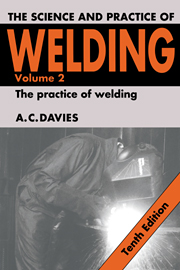Book contents
- Frontmatter
- Contents
- Preface
- 1 Manual metal arc welding
- 2 Gas shielded metal arc welding
- 3 Tungsten electrode, inert gas shielded welding processes (TIG), and the plasma arc process
- 4 Resistance welding and flash butt welding
- 5 Additional processes of welding
- 6 Oxy-acetylene welding
- 7 Cutting processes
- 8 The welding of plastics
- Appendixes
- 1 Welding symbols: British, American
- 2 Simplified notes on the operation of a thyristor
- 3 Proprietary gases and mixtures
- 4 Tests for wear-resistant surfaces
- 5 Conversion factors
- 6 Low hydrogen electrode, downhill pipe welding
- 7 The manufacture of extruded MMA electrodes
- 8 Notes on fire extinguishing
- 9 Table of brazing alloys and fluxes
- 10 Latest plant and equipment
- 11 Refraction and reflection
- 12 Notes on the welding of Duplex and Super Duplex stainless steels
- 13 Welding fumes: health and safety
- 14 Lasers and laser welding
- City and Guilds of London Institute examination questions
- Index
14 - Lasers and laser welding
Published online by Cambridge University Press: 11 May 2010
- Frontmatter
- Contents
- Preface
- 1 Manual metal arc welding
- 2 Gas shielded metal arc welding
- 3 Tungsten electrode, inert gas shielded welding processes (TIG), and the plasma arc process
- 4 Resistance welding and flash butt welding
- 5 Additional processes of welding
- 6 Oxy-acetylene welding
- 7 Cutting processes
- 8 The welding of plastics
- Appendixes
- 1 Welding symbols: British, American
- 2 Simplified notes on the operation of a thyristor
- 3 Proprietary gases and mixtures
- 4 Tests for wear-resistant surfaces
- 5 Conversion factors
- 6 Low hydrogen electrode, downhill pipe welding
- 7 The manufacture of extruded MMA electrodes
- 8 Notes on fire extinguishing
- 9 Table of brazing alloys and fluxes
- 10 Latest plant and equipment
- 11 Refraction and reflection
- 12 Notes on the welding of Duplex and Super Duplex stainless steels
- 13 Welding fumes: health and safety
- 14 Lasers and laser welding
- City and Guilds of London Institute examination questions
- Index
Summary
Notes on the laser
The cost of the CO2 lasers has mitigated against their general acceptance by industry, except for heavier work. They can perform welding, cutting, drilling, spot welding and marking operations quickly and efficiently, with very little distortion, due to the narrow HAZ, but it is still only the larger firms that use them where there is much repetition work. We will discuss the following types of laser here: solid state, such as the Nd–YAG, and gas, such as the CO2 axial flow and the CO2 transverse or cross flow.
The Nd-YAG laser
The Nd-YAG laser is of neodymium and yttrium-aluminium garnet (the last word indicating that its crystals are cubic). This laser is relatively light and portable, and its use is greatly increased by the fact that the laser beam can be conducted along a fibre-optic cable to a gun head, and can thus reach awkward places. It is used for marking hardened parts and no matter how thin, these are clearly marked using a low-power laser (Fig. A14.1). The drilling of thin sheet and stainless steel is performed with a very small focussed beam; the width of the beam determines the hole diameter.
- Type
- Chapter
- Information
- The Science and Practice of Welding , pp. 458 - 466Publisher: Cambridge University PressPrint publication year: 1993



